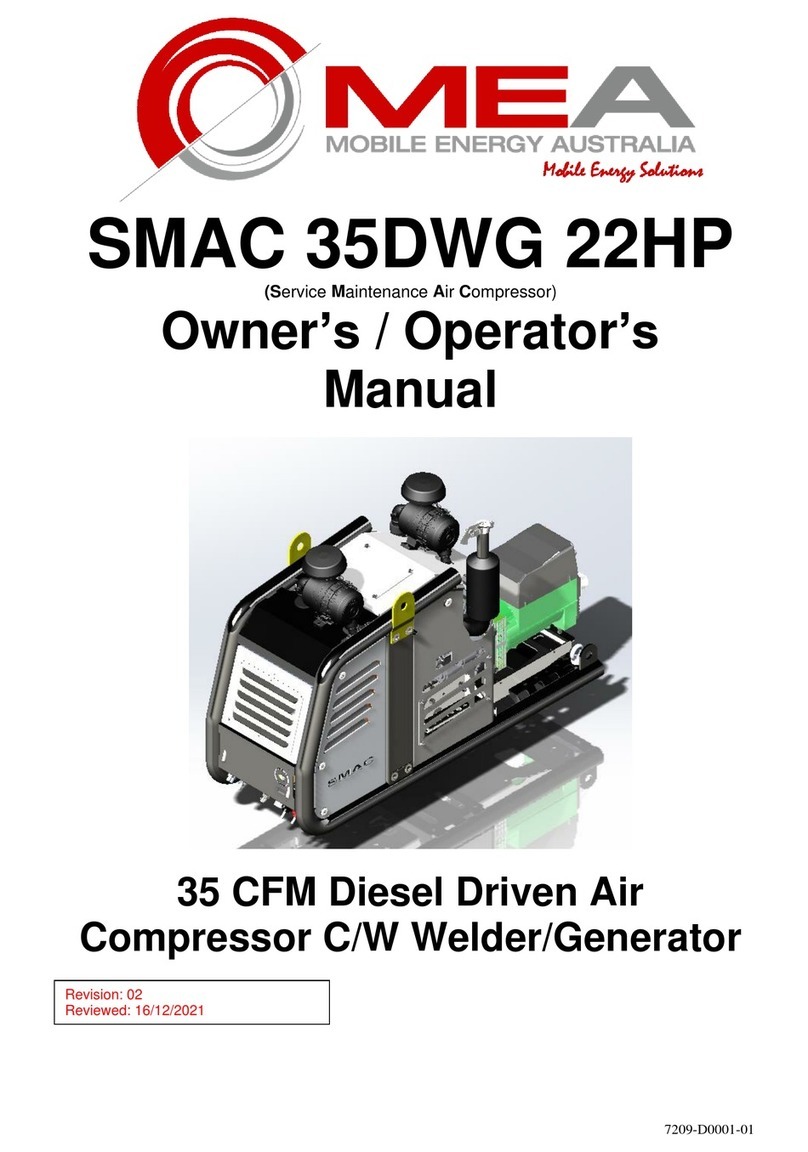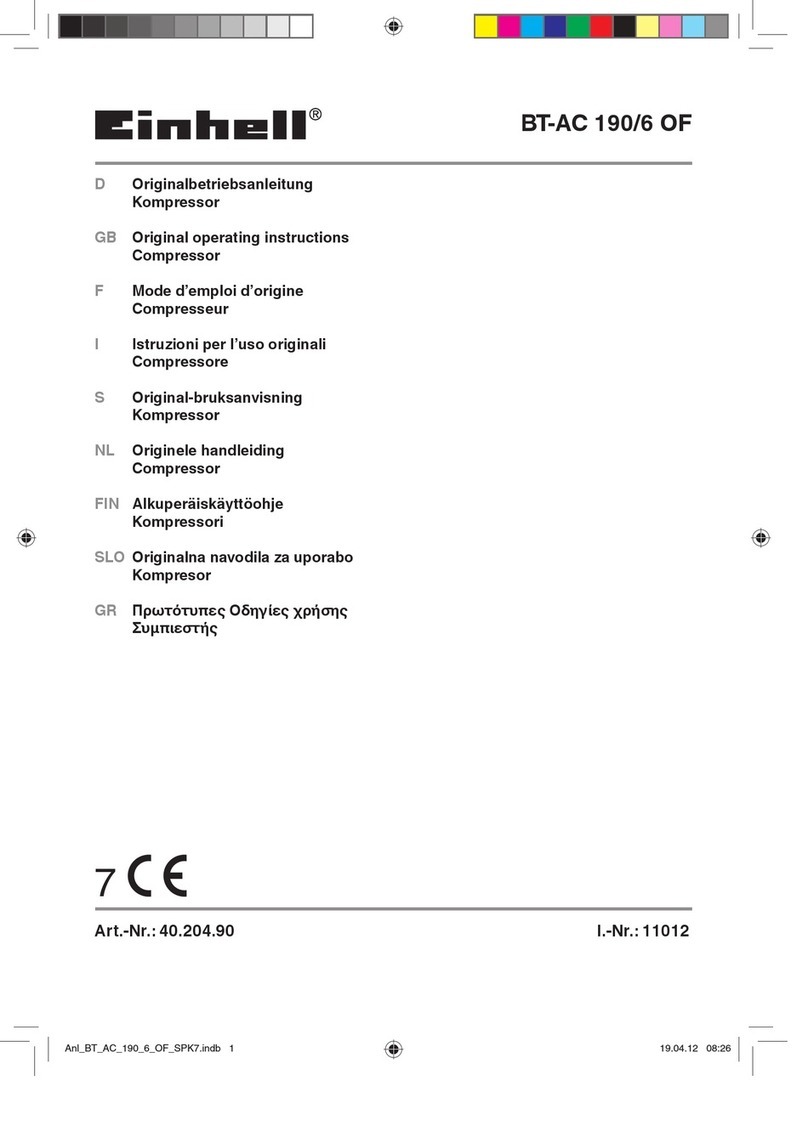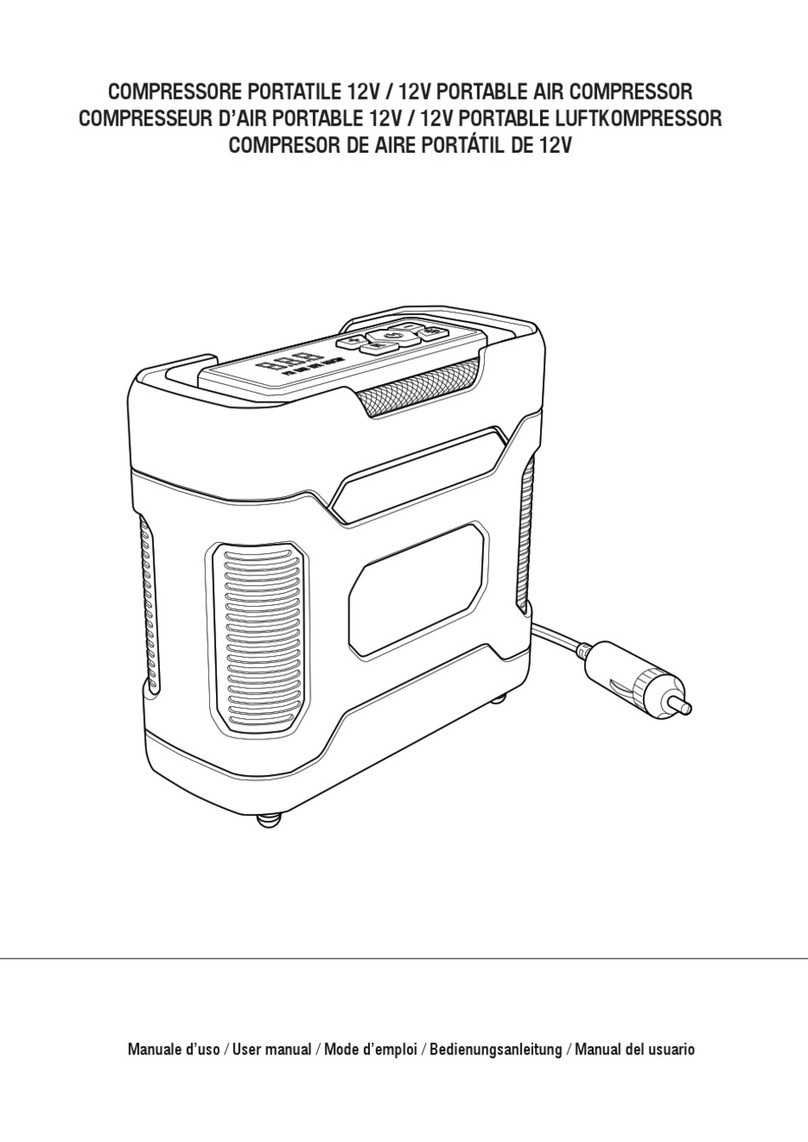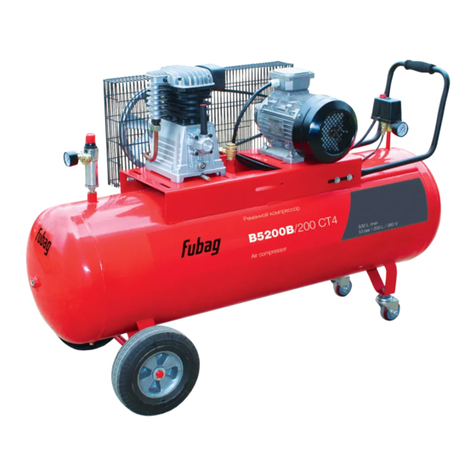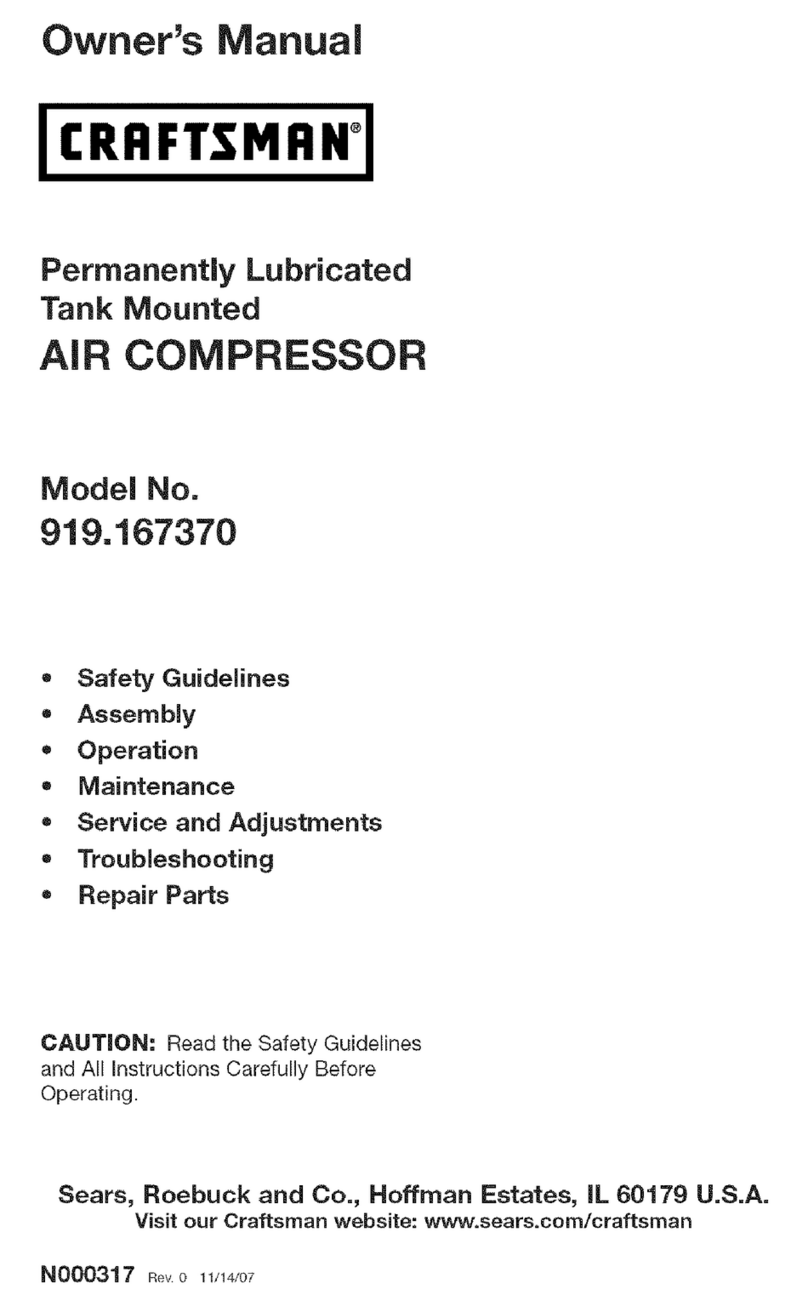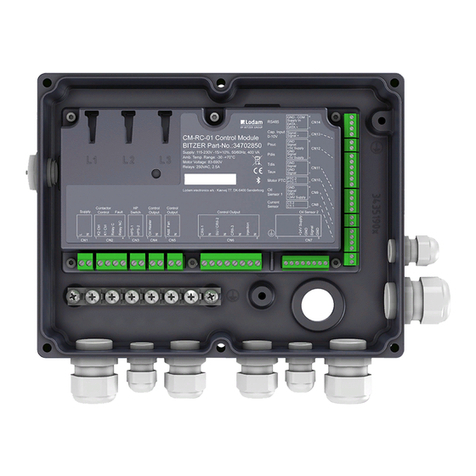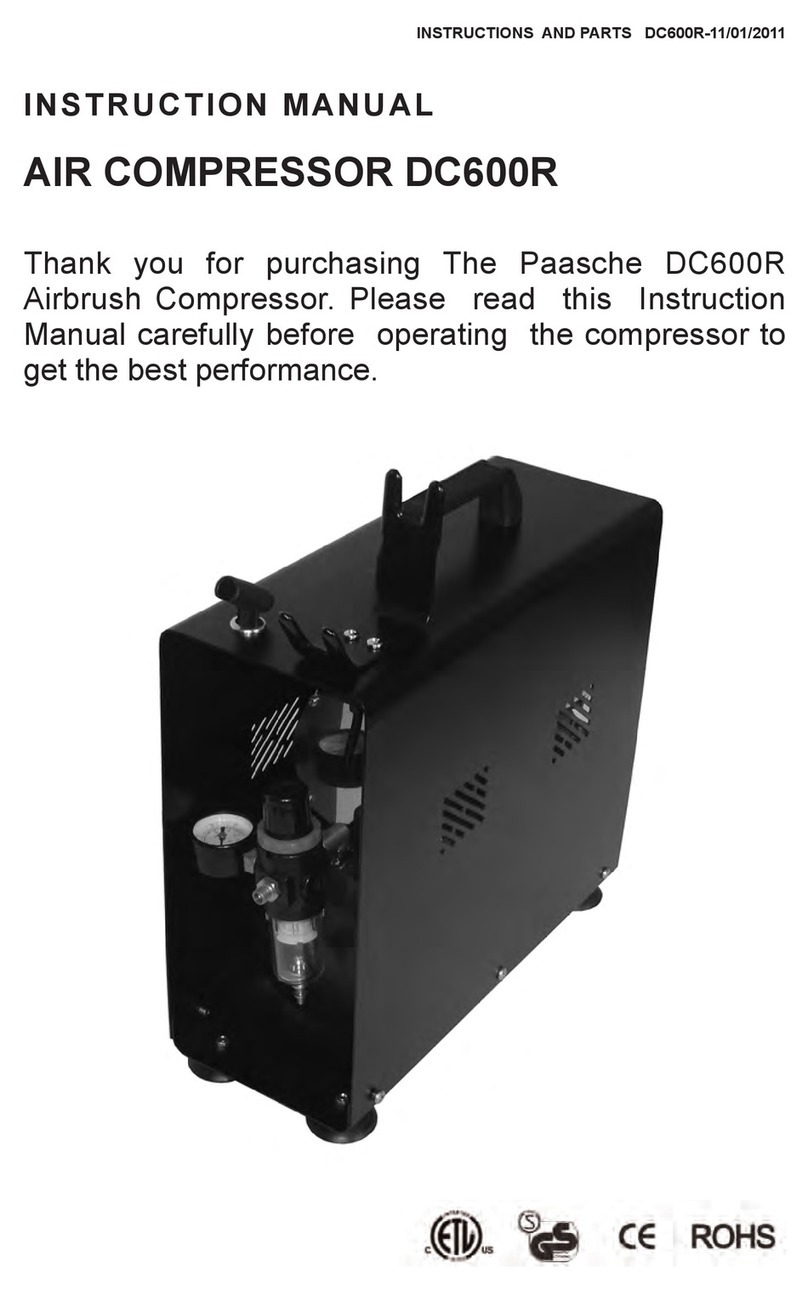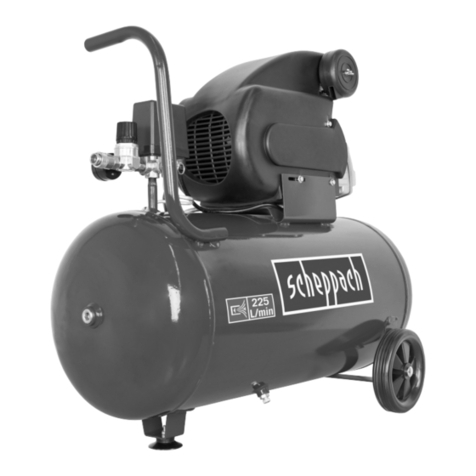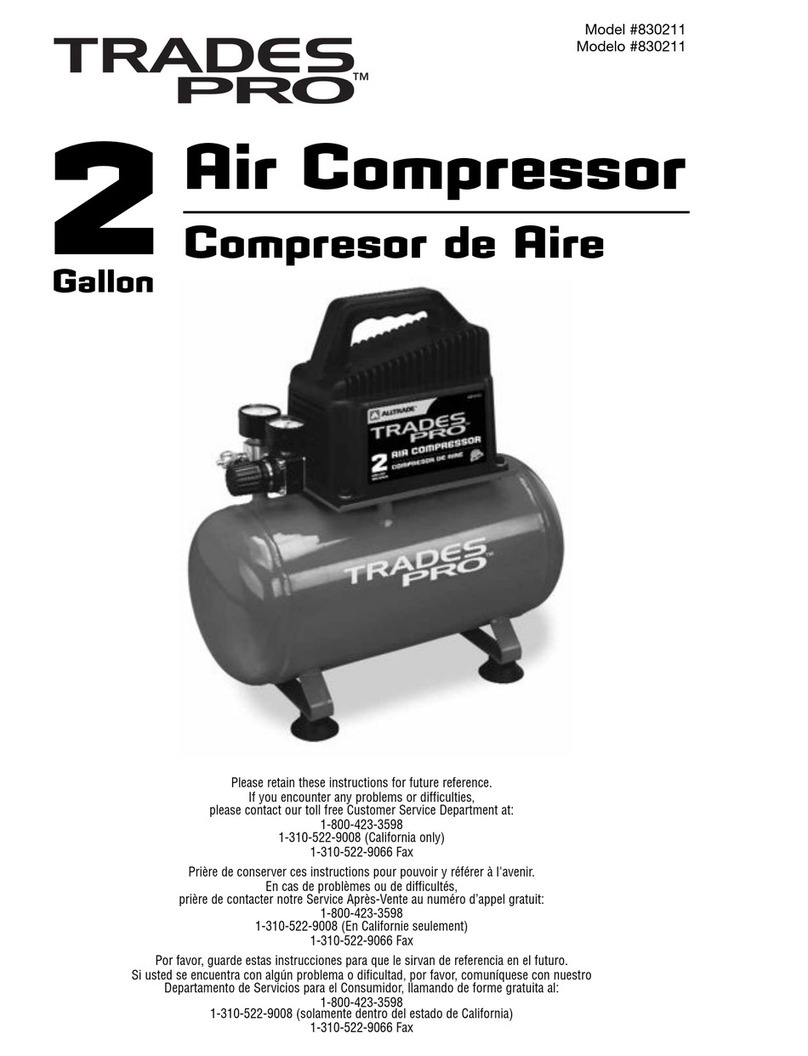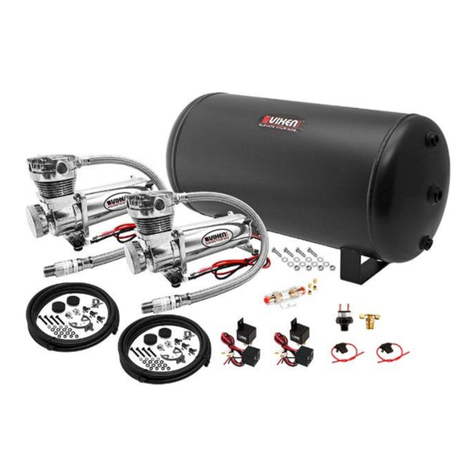Grainger CIAO 6 User manual

Operating Instructions
Instructions d’utilisation et fonctionnement
Instrucciones de uso y funcionamiento
Warnings for safe use of this air compressor are included in this manual
! Le présent manuel mentionne les avis pour une utilisation en toute sécurité du compresseur.
¡En el presente manual están incluidas las advertencias para un uso seguro del compresor!
ELECTRIC AIR COMPRESSORELECTRIC AIR COMPRESSOR
ELECTRIC AIR COMPRESSORELECTRIC AIR COMPRESSOR
ELECTRIC AIR COMPRESSOR
COMPRESSEUR D’AIR ÉLECTRIQUECOMPRESSEUR D’AIR ÉLECTRIQUE
COMPRESSEUR D’AIR ÉLECTRIQUECOMPRESSEUR D’AIR ÉLECTRIQUE
COMPRESSEUR D’AIR ÉLECTRIQUE
COMPRESOR DE AIRE ELÉCTRICOCOMPRESOR DE AIRE ELÉCTRICO
COMPRESOR DE AIRE ELÉCTRICOCOMPRESOR DE AIRE ELÉCTRICO
COMPRESOR DE AIRE ELÉCTRICO
Serialno.:
N° de série:
N° de serie:
a
197CC7900 - ED.2 - 01/2010

2
INTRODUCTION..........................................................................3
SAFETY ALERT ...........................................................................3
INSPECTION ...............................................................................3
1. SAFETY WARNINGS...............................................................4
2. AIR COMPRESSOR FEATURES..............................................8
3. PREPARATION ........................................................................10
4. OPERATION ............................................................................11
5. MAINTENANCE .......................................................................12
6. TROUBLESHOOTING .............................................................12-14
SPECIFICATIONS........................................................................41

3
ENGLISH
INTRODUCTION
Congratulations on the purchase of your new Air Compressor! You can be assured your Air Compressor was
constructedwiththe highestlevelofprecision andaccuracy. Eachcomponenthasbeen rigorouslytestedbytechnicians
to ensure the quality, endurance and performance of this air compressor.
This operator’s manual was compiled for your benefit. By reading and following the simple safety, installation and
operation, maintenance and troubleshooting steps described in this manual, you will receive years of troublefree
operation from your new Air Compressor. The contents of this manual are based on the latest product information
available at the time of publication. The manufacturer reserves the right to make changes in price, color, materials
equipment, specifications or models at any time without notice.
SAFETYALERT!
A”DANGER, WARNING or CAUTION” safety warning will be surrounded by a ”SAFETYALERT BOX”.
This box is used to designate and emphasize Safety Warnings that must be followed when operating
this air compressor. Accompanying the safety warnings are “Signal Words” which designate the
degree or level of hazard seriousness. The “Signal Words” used in this manual are as follows:
DANGER:
Indicates an imminently hazardous situation which, if not avoided, WILL result in death or serious
injury.
WARNING:
Indicates a potentially hazardous situation which, if not avoided, COULD result in death or serious
injury.
CAUTION:
Indicates a potentially hazardous situation which, if not avoided MAY result in minor or moderate
injury or damage to the air compressor.
The symbols set to the left of this paragraph are “Safety Alert Symbols”. These
symbols are used to call attention to items or procedures that could be dangerous to
you or other persons using this equipment.
ALWAYS PROVIDE A COPY OF THIS MANUAL TO ANYONE USING THIS EQUIPMENT. READ ALL
INSTRUCTIONS IN THIS MANUAL AND ANY INSTRUCTIONS SUPPLIED BY MANUFACTURERS OF
SUPPORTING EQUIPMENT BEFORE OPERATING THIS AIR COMPRESSORAND ESPECIALLY POINT
OUT THE “SAFETY WARNINGS” TO PREVENT THE POSSIBILITY OF PERSONAL INJURY TO THE
OPERATOR.
INSPECTION
Unboxtheair compressor and write in theserialnumber in the space provided below.Inspectfor signs of obvious or
concealedfreightdamage.Besure that all damaged partsarereplacedandanymechanicalproblems are corrected
prior to the operation of the air compressor.
SERIAL NUMBER__________________________________________
Please have the following information available for all service calls:
1. Model Number
2. Serial Number
3. Date and Place of Purchase

4
PREVENTION
•Make sure the air compressor is plugged
into a properly grounded outlet which provides
correct voltage and adequate fuse protection.
•Check power cord for signs of crushing,
cutting or heat damage. Replace faulty cord
before use.
•Keep all connections dry and off the
ground. Do not allow electrical cords to lay in
water or in such a position where water could
come in contact with them. Do not touch plug
with wet hands.
•Do not pull on the electrical cord to
disconnect from the outlet.
•Never operate air compressor in wet
conditions or outdoors when it is raining.
•Never operate air compressor with safety
guards/covers removed or damaged.
•Any electrical wiring or repairs performed
on this air compressor should be done by
Authorized Service Personnel in accordance
with National and Local electrical codes.
•Before opening any electrical enclosure,
always shut off the air compressor, relieve
pressure and unplug the air compressor from
the power source.Allow air compressor to cool
down.Neverassumetheaircompressoris safe
to work on just because it is not operating. It
could restart at any time!
•Always operate air compressor in a well
ventilated area free of flammable vapors,
combustible dust, gases or other combustible
materials.
•If spraying flammable material, locate the
air compressor at least 20 feet away from the
spray area. (An additional hose may be
required.)
•Never place objects against or on top of
aircompressor.Operateaircompressoratleast
12inchesawayfromany wall orobstructionthat
would restrict proper ventilation.
HAZARD
RISK
ELECTRIC
SHOCK
OR
ELECTROCUTION
1. SAFETY WARNINGS
READ ALL SAFETY WARNINGS BEFORE USINGAIR COMPRESSOR
RISK OF
EXPLOSION
OR FIRE
POTENTIAL CONSEQUENCE
Seriousinjuryordeathcould occur if the air
compressor is not properly grounded. Your
aircompressorispoweredby electricity and
maycauseelectricshock or electrocution if
not used properly.
Electrical shock may occur from electrical
cord.
Electricalshockmayoccurif aircompressor
is not operated properly.
Serious injury or death may occur if
electrical repairs are attempted by
unqualified persons.
Serious injury or death may occur from
normal electrical sparks in motor and
pressure switch
Serious injury may occur if any air
compressor ventilation openings are
restricted, causing the air compressor to
overheat and start on fire.

5
ENGLISH
HAZARD
RISK OF
BURSTING
POTENTIAL CONSEQUENCE
Serious injury or death may occur from an
airtankexplosionifair tanksarenotproperly
maintained.
Serious injury may occur from an air
compressor malfunction or exploding
accessories if incorrect system
components, attachments or accessories
are used.
Serious injury or death could occur from
inhalingcompressedair.Theairstream may
contain carbon monoxide, toxic vapors or
solid particles.
Sprayed materials such as paint, paint
solvents,paint remover,insecticides,weed
killers, etc. contain harmful vapors and
poisons.
Serious injury could occur from touching
exposed metal parts.
These areas can remain hot for some time
after the air compressor is shutdown.
Soft tissue damage can occur from the
compressed air stream.
Serious injury can occur from loose debris
being propelled at a high speed from the
compressed air stream.
PREVENTION
•Drain air tank daily or after each use to
prevent moisture buildup in the air tank.
•If air tank develops a leak, replace the air
tank immediately. Never repair, weld or make
modificationsto the air tankoritsattachments.
Use only genuine repair parts for your air
compressor.
•Nevermakeadjustmentstothefactoryset
pressures.
•Never exceed manufacturers maximum
allowable pressure rating of attachments.
•Because of extreme heat, do not use
plastic pipe or lead tin soldered joints for a
discharge line.
•Neveruseaircompressortoinflatesmall,
low pressure objects such as toys.
•Never inhale air from the air compressor
either directly or from a breathing device
connected to the air compressor.
•Operate air compressor only in a well
ventilated area. Follow all safety instructions
provided with the materials you are spraying.
Use of a respirator may be required when
working with some materials.
•Neverallowanypartofyour body or other
materials to make contact with any exposed
metal parts on the air compressor.
•AlwayswearOSHArequired“Z87”safety
glasses to shield the eyes from flying debris.
•Never point the air stream at any part of
your body, anyone else or animals.
•Never leave pressurized air compressor
unattended.Shutoffaircompressorand relieve
pressure before attempting maintenance,
attaching tools or accessories.
•Always maintain a safe distance from
people and animals while operating the air
compressor.
•Do not move the air compressor while air
tankisunderpressure.Donotattempttomove
the air compressor by pulling on the hose.
RISK TO
BREATHING
RISK OF
BURNS
1. SAFETY WARNINGS1. SAFETY WARNINGS
1. SAFETY WARNINGS1. SAFETY WARNINGS
1. SAFETY WARNINGS
1. SAFETY WARNINGS
READALL SAFETY WARNINGS BEFORE USINGAIR COMPRESSOR
RISK
OF FLYING
OBJECTS

6
SAVE THESE INSTRUCTIONS
HAZARD PREVENTION
•Always turn off air compressor. Bleed
pressure from the air hose and unplug from
electricaloutletbeforeperforming maintenance.
Allrepairsto theaircompressorshouldbemade
by anAuthorized Service person. Never assu-
me the air compressor is safe to work on just
because it is not operating. It could restart at
any time!
•Do not operate without protective covers/
guards. Replace damaged covers/guards
before using the air compressor.
•Never allow children or adolescents to
operate this air compressor!
•Stay alert-watch what you are doing. Do
not operate the air compressor when fatigued
or under the influence of alcohol or drugs.
•Know how to stop the air compressor. Be
thoroughly familiar with controls.
•Do not operate air compressor without an
air filter.
•Do not operate air compressor in a corro-
sive environment.
•Do not incline the air compressor
transversely or longitudinally more than 10°.
•Ensurethe oil level isabove the minimum
notch and below the maximum notch on the
dipstick. If low, add with ISO 100 compressor
pump oil.
•Always operate the air compressor in a
stable, secure position to prevent air
compressor from falling.
•Follow all maintenance instructions listed
in this manual.
POTENTIAL CONSEQUENCE
Riskofbodilyinjuryfrommovingparts.This
air compressor cycles automatically when
the pressure switch is in the “On/Auto”
position.
Risk of injury from negligent use.
Risk of major repair.
1. SAFETY WARNINGS1. SAFETY WARNINGS
1. SAFETY WARNINGS1. SAFETY WARNINGS
1. SAFETY WARNINGS
1. SAFETY WARNINGS
READ ALL SAFETY WARNINGS BEFORE USINGAIR COMPRESSOR
RISK FROM
MOVING PARTS
RISK FROM
NEGLIGENCE
RISK
OF AIR
COMPRESSOR
DAMAGE

7
ENGLISH
2. AIR COMPRESSOR FEATURES
BI-TANK
BI-TANK WHEELED
SCOUT
1. Pressure Switch
2. Thermal Overload / Reset
3. Air Intake Filter
4. Air Compressor Pump
5. SafetyValve
6. Air tank drain valve
7. Tank Pressure Gauge
8. Outlet Pressure Gauge
9. Pressure Regulator
10. Oil Dipstick
11. Oil Drain
12. Discharge Line
13. Electric Power Cord
14. Ventilation Openings / Protective Shroud
15. Quick coupling
16. Intake valve
17. Cold start valve
a
+-
1
2
3
4
5
6
7 89
10
11
12
13
14
15
16
17

8
2. AIR COMPRESSOR FEATURES
BIG PIONEER
CIAO 6
1. Pressure Switch
2. Thermal Overload / Reset
3. Air Intake Filter
4. Air Compressor Pump
5. SafetyValve
6. Air tank drain valve
7. Tank Pressure Gauge
8. Outlet Pressure Gauge
9. Pressure Regulator
10. Oil Dipstick
11. Oil Drain
12. Discharge Line
13. Electric Power Cord
14. Ventilation Openings / Protective Shroud
15. Quick coupling
16. Intake valve
17. Cold start valve
1
23
14
5
6
7
8
9
10
11
12
13
4
15
16
17
TIGER

9
ENGLISH
2. AIR COMPRESSOR FEATURES
1) MOTOR/PRESSURE SWITCH: This switch is used to
start or stop the air compressor. Moving the switch to the
“On”positionwillprovideautomaticpowertothe pressure
switch which will allow the motor to start when the air
tank pressure is below the factory set “cut-in” pressure.
Wheninthe “ON ” position, the pressure switch stopsthe
motor when the air tank pressure reaches the factory set
“cut out” pressure. For safety purposes, this switch also
has a pressure release valve located on the side of the
switchdesignedtoautomatically release compressed air
from the air compressor pump head and its discharge
line when the air compressor reaches “cut-out” pressure
orisshutoff.Thisallows themotortorestartfreely.Moving
the switch to the “Off” position will remove power from
the pressure switch and stop the air compressor.
2) MOTOR THERMAL OVERLOAD:
The electric motor has a
manual thermal overload
protector. If the motor
overheats for any reason, the
thermal overload will cut off
power, thus preventing the
motor from being damaged.
Wait until the motor is cool
before pressing the thermal
overload button to reset and
begin working again.
3) AIR INTAKE FILTER: This filter is designed to clean
aircomingintothepump.Toensurethepumpcontinually
receivesaclean,cool,dry airsupplythisfiltermustalways
be clean and ventilation opening free from obstructions.
The filter can be removed for cleaning by using warm,
soapy water. Rinse the filter and air dry. Replace filter
whennecessary.
4) AIR COMPRESSOR PUMP: To compress air, the
pistons move up and down in the cylinders. On the
downstroke, air is drawn in through the air intake valves
whiletheexhaustvalvesremainclosed.Ontheupstroke,
air is compressed, the intake valves close and
compressedairis forced out through the exhaustvalves,
into the discharge line, through the check valve and into
the air tank.
5) SAFETY RELIEF VALVE:
Thisvalveisdesignedto prevent
system failures by relieving
pressure from the system when
the compressed air reaches a
predetermined level. The valve
is preset by the manufacturer and must not be modified
in any way. To verify the valve is working properly, pull on
the ring. Air pressure should escape. When the ring is
released, it will reseat.
6)AIR TANK DRAIN VALVE:
The drain valve is
used to remove
moisturefromtheair
tank(s) after the air
compressor is shut
off. NEVER attempt
to open the drain
valve when more
than 10 PSI of air
pressure is in the
air tank! To open the drain valve, turn the knob
counterclockwise.
7)AIR TANK PRESSURE GAUGE:The air tankpressure
gauge (A) indicates the reserve air pressure in the air
tank (s).
8) OUTLET PRESSURE GAUGE: The outlet pressure
gauge(B)indicatestheairpressureavailableatthe outlet
side of the regulator. This pressure is controlled by the
regulator and is always less or equal to the air tank
pressure.
9) PRESSURE REGULATOR: The air pressure coming
from the air tank is controlled by the regulator knob (C).
Turn the pressure regulation knob clockwise to increase
discharge pressure, and counterclockwise to decrease
discharge pressure.
10) OIL DIPSTICK: The dipstick will
register the amount of oil in the pump.
Oil level should be checked on a daily
basis to ensure it does not exceed the
maximum notch or fall below the
minimum notch on the dipstick
OFF AUTO
OFF ON
B
A
C
B
A
C

10
3. PREPARATION
INITIAL SET-UP
1. Read safety warnings before setting-up air compressor.
2. Ensure the oil level is above the minimum notch and below the maximum notch on the dipstick. If low, add
compressor pump oil.
LOCATION
CAUTION: In order to avoid damaging the air compressor, do not incline the air compressor
transversely or longitudinally more than 10°.
Place air compressor at least 12 inches away from obstacles that may prevent proper ventilation. Do not place air
compressor in an area:
where there is evidence of oil or gas leaks.
where flammable gas vapors or materials may be present.
WARNING:
Serious injury or death may occur if electrical sparks from motor and pressure switch come in
contact with flammable vapors, combustible dust, gases or other combustible materials. When using
the air compressor for spray painting, place the air compressor as far away from the work area as
possible, using extra air hoses instead of extension cords.
where air temperatures fall below 32°F or exceed 104°F.
where extremely dirty air or water could be drawn into the air compressor.
ELECTRICAL
DANGER: Improper connection of the equipment-grounding conductor can result in a risk of shock
or electrocution. Check with a qualified electrician or service personnel if you are in doubt as to
whether the outlet is properly grounded. Do not use any type of adapter with this product. If repair or
replacement of the cord or plug is necessary, do not connect the grounding wire to either flat blade
terminal. The wire with insulation having an outer surface that is green with or without yellow stripes
is the grounding wire.
WARNING: This product must be grounded. If there should be a malfunction or breakdown,
grounding provides a path of least resistance for electric current to reduce the risk of electric shock.
This product is equipped with a cord having an equipment-grounding conductor and a grounding
type plug. The plug must be plugged into an appropriate outlet that is properly installed and
grounded in accordance with all local codes and ordinances.
•The Manufacturer DOES NOT RECOMMEND THE USE OF EXTENSION CORDS as this can create power
loss and overheating of the motor. Use of an additional air hose is recommended rather than an extension cord. If
use of an extension cord is unavoidable, it should be plugged into a GFCI found in circuit boxes or protected
receptacles. When using an extension cord, observe the following:
Cable Length Wire Gauge
Up to 25 feet 12 AWG
Up to 100 feet 10 AWG
Up to 150 feet 8 AWG
Up to 250 feet 6 AWG
Useonly3-bladeextensioncordsthathave 3-blade grounding-type plugs and 3-slot cord connectors that will accept
theplugfromtheproduct. Use only extension cords having an electrical rating not lessthantheratingofthe product.
Do not use damaged extension cords. Examine extension cord before using and replace if damaged. Do not abuse
extensioncordand do not yank on any cord todisconnect.Keep cord away from heat and sharpedges.Alwaysshut
off the air compressor switch before removing the plug from the receptacle.

11
ENGLISH
4. OPERATION
PRE-START CHECKLIST:
1. Check oil level.Add if necessary.
2. Removeanymoistureinthe air compressor air tank.Removeexcessive pressure with an air tool, then open the
air tank drain valve in the bottom of the air tank. Close tightly when drained.
WARNING: Risk of bodily injury. NEVER attempt to open the drain valve when more than 10 PSI of
air pressure is in the air tank!
3. Make sure the air compressor Motor Switch is in the “OFF” position.
4. Make sure all safety valves are working correctly.
5. Make sure all guards and covers are in place and securely mounted.
START-UP
Read safety warnings before performing operation.
1. Ensure the lever on the pressure switch box is in the “OFF” position.
2. Plug the power cord into a grounded outlet.
3. Move the lever on the pressure switch box to the “AUTO” position.
4. Set pressure by adjusting the pressure regulator knob counterclockwise for less pressure and clockwise for
more pressure.
5. If you notice any unusual noise or vibration, stop the air compressor and refer to “Troubleshooting”.
SHUTDOWN
1. To stop the air compressor, move the lever on the pressure switch box to the “OFF” position. NEVER stop the
air compressor by unplugging it from the power source. This could result in risk of electrocution.
2. Drain air from the air tanks by releasing air with an attached air tool or by pulling on the safety relief valve ring.
3. Once pressure in the air tanks register under 10 pounds, open the drain valve under each air tank to drain any
moisture.
4. Allow the air compressor to cool down.
5. Wipe air compressor clean and store in a safe, warm area.

12
5. MAINTENANCE
Read the instruction manual before performing maintenance. The following procedures must be performed when
stopping the air compressor for maintenance or service.
1. Turn off air compressor.
WARNING: Never assume the air compressor is safe to work on just because it is not operating. It
could restart at any time!
2. Disconnect cord from main power supply.
3. Open all drains.
4. Wait for the air compressor to cool before starting service.
MAINTENANCE CHART
PROCEDURE DAILY WEEKLY MONTHLY 200 HOURS
Check pump oil level X
Oil leak inspection X
Drain condensation in air tank(s) X X
Check for unusual noise/vibration X
Check for air leaks X
Inspect air filter X
Clean exterior of compressor X
Check safety relief valve X
Change pump oil* X
Replace air filter X
*The pump oil must be changed after the first 50 hours of operation and every 200 hours or 3 months, whichever
comes first. We recommend using a straight weight detergent oil that is specifically blended for air compressor.
6. TROUBLESHOOTING
CHECKLIST
PROBLEM
•Air compressor will
not start
•Guest complains of
excessive trippings of
reset button
•Intake filter or gauge
is broken
CAUSE
Reset button for thermal overload
protection has tripped
Tank pressure has reached top-end
pressure switch setting
Oil too thick due to storage in colder
temperatures.
Machine is brand new and needs to
be “broken in”.
Improper gauge of extension cord is
being used.
Shippingdamageor inadvertentguest
error.
REMEDY
Locatereset(red)button,andpressitfirmlyuntil
click is heard. Evaluate oil weight, use of
extension cords etc.
Drain or use compressed air until low-end
pressure setting is reached.
Changeoiltosynthetic blend or winter grade air
compressor oil, and/or open tank drain(s), and
allow pump to run fro 30/60 seconds unloaded
before attemping to cycle machine normally.
Open tank drain to start, and keep drain slightly
open to force additional cycling until break-in
period is reaching (40 hrs.)
Make sure guest is using 12 gauge (maximum
25’)or10gauge(maximum50’)extensioncord.
Contact after sales service for replacement
For additional informations and/or different problems, please read carefully the following pages

13
ENGLISH
6. TROUBLESHOOTING
CAUSE REMEDY
Lack of oil in the pump.
Carbon deposits on pistons or valves.
Bearing, piston or connecting rod failure.
Add correct amount of oil. Check for bearing damage.
Remove cylinder head and inspect. Clean or replace.
STOP THE COMPRESSOR!
Contact Customer Service.
Air compressor is incorrectly sized. Limittheairpressure tothecapacityofthe aircompressor.
Either use a smaller tool or a larger air compressor.
Symptom 2. Noisy operation
Symptom 3. When in the start/stop option, motor runs continuously
Symptom 4. Air continues to leak at motor/pressure switch relief valve after motor stops.
Defective check valve, is stuck open. Remove, clean or replace.
Symptom 5. Air continues to leak at motor/pressure switch release valve while motor is running.
Defective motor/pressure switch. Replace
Symptom 6. Air leaks from safety relief valve.
Possible defective safety relief valve.
Excessive air tank pressure.
Operate safety relief valve manually by pulling on ring.
If it still leaks, it should be replaced.
Defective pressure switch. Replace.
Symptom 7. Air leaks at pump
Defective gasket Replace and torque head bolts to 8 ft./lbs
Power cord not plugged in.
Motor/Pressure switch in “OFF” position.
Motor thermal overload switch has tripped.
Fuse blown or circuit breaker has tripped.
Wrong gauge wire or length of extension cord.
Pressurereleasevalveonmotor/pressureswitchhasnot
unloaded pump head pressure
Tank check valve stuck open
Defective motor, capacitor, pressure switch, or check
valve.
Plug cord into grounded outlet.
Move switch to “AUTO” position.
Turnaircompressoroff,waituntilmotoriscool, thenpress
motor thermal overload (red) button firmly until click is
heard.
Replace fuse or reset circuit breaker.
Check for proper fuse; only “Fusetron” type T fuses are
acceptable.
Check for low voltage conditions.
Disconnectanyother electrical appliances from circuit or
operate air compressor on its own branch circuit.
Check chart on page #10 for proper gauge wire and cord
length.
Bleed the line by moving the switch to the “Off” position
Remove and clean or replace
Contact Customer Service.
Symptom 1. Motor will not run or restart.

14
CAUSE REMEDY
6. TROUBLESHOOTING
Condensation in air tank caused by high level of
atmospheric humidity or air compressor is not run long
enough.
Drain air tank after every use. Drain air tank more often
in humid weather and use an air line filter.
Restricted air intake filter.
Defective (reed) valve.
Restricted check valve
Clean or replace.
Drain air tank and measure pump up time. Compare to
specifications.Iflower, removepump head and inspect
valve plate, clean or replace.
Clean or replace
Symptom 12. Air compressor not making enough air.
Symptom 13. Excessive oil consumption in pump.
Restricted air intake filter.
Air compressor on unlevel surface.
Crankcase overfilled with oil.
Plugged oil dipstick vent.
Oil leaks.
Worn piston rings or scored cylinder.
Clean or replace.
Do not incline the air compressor more than 10° in any
direction while running.
Drain oil. Refill to proper level with oil.
Clean.
Repair.
Contact Customer Service.
Symptom 14. Oil has milky appearance.
Water in oil due to condensation. Change oil and move air compressor to a less humid
environment.
Symptom 15. Moisture in discharge air.
Symptom 8. Air leaks at fittings.
Fittings are not tight enough. Tightenfittingswhereaircanbeheardescaping.Check
fittings with soapy water solution. Do not overtighten.
Symptom 9. Air leaks in air tank
Defective or rusted air tank Airtankmustbereplaced.Donotattempttorepairtank.
Symptom 10. Air blowing from intake filter
Damaged inlet (reed) valve Contact Customer Service.
Symptom 11. Insufficient pressure at air tool or accessory.
Pressure regulator knob not turned to high enough
pressure or defective pressure regulator. Adjust pressure regulator knob to proper setting or
replace.
Symptom 11. Insufficient pressure at air tool or accessory.
Restricted air intake filter.
Air leaks.
Hose or hose connections are too small or long.
Air compressor is not large enough for air requirement.
Clean or replace.
Check for leaks and repair.
Replace with larger hose or connectors.
Check the accessory air requirement. If it is higher than
the CFM or pressure supply of the air compressor, you
need a larger air compressor.

15
FRANÇAIS
INTRODUCTION ..................................................................................16
VISITE...................................................................................................16
1. AVIS DE SÉCURITÉ .........................................................................17
2. CARACTÉRISTIQUES DU COMPRESSEUR ..................................20
3. PRÉPARATION.................................................................................24
4. FONCTIONNEMENT ........................................................................25
5. ENTRETIEN......................................................................................25
6. DÉTECTION PANNES......................................................................26
SPÉCIFICATIONS TECHNIQUES........................................................41

16
INTRODUCTION
INTRODUCTION
Tous nos compliments pour avoir choisi un compresseur Prime! Les compresseurs sont réalisés avec la précision
maximum et chaque composant est rigoureusement testé par nos techniciens en vue d’en garantir la qualité, la
durée et ses performances.
Ce manuel a été rédigé pour aider l’opérateur. Il est préconisé de suivre les instructions tout à fait simples de
sécurité,installation,fonctionnement, entretien etdétectiondepanne,qui ysontdécritespourobteniruncompresseur
FINI parfaitement performant et d’une longue durée. Les indications figurant sur ce manuel se basent sur les
dernières informations du produit disponibles lors de la publication. Le constructeur se réserve le droit d’apporter
des modifications à : prix, coloris, matériaux et spécifications techniques ou modèles à tout moment sans aucun
préavis.
ALARME DE SÉCURITÉ
Lesavisde sécurité du type “DANGER,ATTENTION ouAVIS” sontcontenusdans un “ENCADRÉALARME DE
SÉCURITÉ”. Cet encadré est utilisé pour définir ou souligner des avis de sécurité qu’il faut respecter au cours
de l’utilisation du compresseur. Les avis de sécurité sont accompagnés de “Signaux” qui indiquent le degré ou
le niveau de danger. Les “Signaux” utilisés sur ce manuel sont les suivants :
DANGER : indique une situation de danger imminent qui COMPORTERA la mort ou des lésions corporelles
graves, au cas où elle ne serait pas évitée.
ATTENTION : indique une situation potentiellement dangereuse qui PEUT comporter la mort ou des lésions
corporelles graves, au cas où elle ne serait pas évitée.
AVIS :indiqueune situation potentiellement dangereuse qui POURRAITcomporterdeslésionscorporellesnon
graves ou un endommagement du compresseur, au cas où elle ne serait pas évitée.
Lessymbolesreportésàgauchedeceparagraphesontdes“symbolesd’alarmedesécurité”.
Ces symboles sont utilisés en vue de rappeler l’attention sur des éléments ou procédés qui
pourraients’avérerdangereuxpourvousou pour lespersonnesquiseserventdecet outillage.
TOUJOURS FOURNIR UNE COPIE DE CE MANUEL A QUICONQUE UTILISERAIT CET
APPAREILLAGE. LIRE TOUTES LES INSTRUCTIONS REPORTÉES SUR CE MANUEL ET TOUTEAUTRE
INSTRUCTION FOURNIE PAR D’AUTRES CONSTRUCTEURS DES STRUCTURES DE SUPPORTAVANT
DE METTRE EN FONCTION LE COMPRESSEUR. PRIÈRE EN OUTRE DE PRÊTER UNE ATTENTION
TOUTE PARTICULIÈRE À TOUS LES “ AVIS DE SÉCURITÉ”, AFIN DE PRÉVENIR LA POSSIBILITÉ DE
LÉSIONS CORPORELLES DE L’OPÉRATEUR.
VISITE
Retirerlecompresseurde l’emballage et écrire le numéro de série dansl’emplacementappropriésitué au-dessous.
Vérifier la présence éventuelle de marques d’endommagements dus au transport. Vérifier que toutes les parties
endommagées sont remplacées et que tout problème mécanique a été résolu avant la mise en fonction du
compresseur.
NUMÉRO DE SÉRIE
Pour toute demande d’assistance, tenir toujours à portée de la main les informations suivantes :
1. numéro modèle
2. numéro de série
3. date et lieu d’achat

17
FRANÇAIS
RISQUE DE
DÉCHARGES
ÉLECTRIQUES
OU
ÉLECTROCUTION
1. AVIS DE SÉCURITÉ
LIRE TOUS LES AVIS DE SÉCURITÉAVANT D’UTILISER LE COMPRESSEUR
Si la mise à la terre du compresseur n’est
pas parfaitement exécutée, il persiste le
risque de graves lésions corporelles ou de
mort. Le compresseur étant alimenté par
le courant électrique, cela pourrait causer
desdéchargesélectriquesouélectrocution,
au cas où il serait utilisé d’une façon
impropre.
Les décharges électriques peuvent être
causées par le câble électrique.
Risque de décharges électriques en cas
d’utilisation impropre du compresseur.
Risquedegraveslésionscorporellesoude
mort en cas de réparations électriques
effectuées par un personnel non qualifié.
•Vérifier que la fiche du compresseur est
bien enfoncée dans une prise dotée de la mise
àlaterreappropriée,enmesured’autoriserune
alimentation parfaite et une protection avec
fusible.
•Vérifier les marques éventuelles
d’écrasement,entailleouendommagementpar
suited’échauffementsurlecâble d’alimentation.
Remplacer les câbles défectueux avant
l’utilisation.
•Maintenir toutes les connexions bien
sèches et soulevées du sol. Ne pas mettre de
câbles électriques dans l’eau et dans une telle
position qu’il puisse s’établir un contact avec
celle-ci. Ne pas toucher la fiche avec les mains
mouillées.
•Ne pas tirer le câble électrique pour le
déconnecter de la prise.
•Il ne faut jamais utiliser le compresseur
dans des zones mouillées ou à l’extérieur
lorsqu’il pleut.
•Il ne faut jamais utiliser le compresseur
avec les protections/couvertures de sécurité
enlevées ou endommagées.
•Tous les câblages électriques ou les
réparations du compresseur doivent être
exécutées par un personnel d’assistance
autorisé conformément aux réglementations
électriques locales et nationales.
•Avantd’ouvrir quelqueboîteélectriqueque
ce soit, débrancher toujours le compresseur,
décharger la pression et déconnecter le
compresseurduréseau d’alimentation.Laisser
refroidir le compresseur. Même si le
compresseur n’est pas en train de fonctionner,
celane veut pasdirequel’onpeut intervenir en
toute sécurité, en effet il pourrait se remettre
en marche à tout moment.
!CONSERVER CES INSTRUCTIONS !
DANGER CONSÉQUENCES POTENTIELLES PRÉVENTION

18
RISQUE DE
BRÛLURES Le contact avec des pièces métalliques
exposées peut entraîner de graves lésions
corporelles, du fait que ces pièces restent
chaudespendant un certainlapsdetemps,
même après que le compresseur a été mis
hors service.
•Empêcher toujours le contact de votre
corps ou d’autres matériaux avec n’importe
quelle partie métallique exposée du
compresseur.
RISQUE
D’ÉCLATEMENT
RISQUE
D’INHALATION
1. SAFETY WARNINGS1. SAFETY WARNINGS
1. SAFETY WARNINGS1. SAFETY WARNINGS
1. SAFETY WARNINGS
1. AVIS DE SÉCURITÉ
LIRE TOUS LES AVIS DE SÉCURITÉAVANT D’UTILISER LE COMPRESSEUR
RISQUE
D’EXPLOSION
OU D’INCENDIE
Au cas où des étincelles électriques
normales gagneraient le moteur et le
pressostat, cela pourrait causer de graves
lésions corporelles ou même la mort.
L’occlusion partielle des ouvertures de
ventilation du compresseur à la suite d’une
surchauffedel’airetd’unprinciped’incendie
pourrait occasionner de graves lésions
corporelles.
•Utilisertoujourslecompresseurdansune
zone bien ventilée, libre de vapeurs
inflammables,poudresdecombustible,gazou
d’autres matières combustibles.
•En cas de pulvérisation de matières
inflammables,maintenirlecompresseur à une
distance d’au moins 20 pieds de la zone de
pulvérisation.(Ilsepourraitqu’il soit nécessaire
d’avoir recours à un tube supplémentaire).
•Il ne faut jamais placer d’objets contre ou
sur le compresseur. Utiliser le compresseur à
une distance d’au moins 12 pouces de parois
ou d’éléments d’obstruction qui pourraient
empêcher une bonne ventilation.
Un entretien non parfait du réservoir à air
peut occasionner de graves lésions
corporelles ou même la mort à cause de
son l’explosion.
Des anomalies au compresseur ou une
explosion d’accessoires peuvent
occasionnerdegraves lésions corporelles,
au cas où l’on utiliserait des composants,
raccordements et accessoires de système
non adéquats.
•Faire évacuer l’air du réservoir tous les
jours afin de prévenir des dépôts d’humidité à
son intérieur.
•Aucasoùl’onconstateraitdesfuitesdans
le réservoir à air, le changer immédiatement. Il
ne faut réparer, souder ou apporter de
modifications au réservoir à air ou à ses
raccordements. Utiliser exclusivement des
pièces de rechange d’origine.
•Ilnefautjamaiseffectuerderéglagesaux
pressions préétablies par le constructeur.
•Il ne faut jamais dépasser la pression no-
minalemaximaleautoriséedesraccordements.
•Ne pas avoir recours à des tubes en
plastique ou à des joints ayant une soudure en
étain pour la ligne de décharge à cause de la
chaleur extrême.
•Nepasutiliserle compresseurpourgonfler
de petits objets à basse pression tels que par
exemple des jouets.
L’inhalation d’air comprimé peut
occasionner de graves lésions corporelles
mêmelamort,lefluxd’air pouvant contenir
du monoxyde de carbone, des vapeurs
toxiques ou des particules solides.
Des matériaux pulvérisés tels que
peintures, solvants, diluants, insecticides,
herbicides, etc. contiennent des vapeurs
nocives et des poisons.
•Ne jamais inhaler d’air du compresseur
directement ou d’un appareil respiratoire relié
au compresseur.
•Utiliser le compresseur exclusivement
dans des zones bien ventilées. Suivre toutes
les instructions de sécurité jointes au matériau
à pulvériser. L’emploi de quelques matériaux
pourrait exiger l’utilisation d’un appareil
respiratoire.
DANGER CONSÉQUENCES POTENTIELLES PRÉVENTION

19
FRANÇAIS
RISQUE
D’ÉJECTION
D’OBJETS
1. SAFETY WARNINGS1. SAFETY WARNINGS
1. SAFETY WARNINGS1. SAFETY WARNINGS
1. SAFETY WARNINGS
1. AVIS DE SÉCURITÉ
LIRE TOUS LES AVIS DE SÉCURITÉAVANT D’UTILISER LE COMPRESSEUR
RISQUE
D’ORGANES EN
MOUVEMENT
Lefluxdel’aircomprimépeut endommager
des tissus souples.
On peut vérifier de graves lésions
corporelles à cause de fragments éjectés à
haute vitesse par le flux d’air comprimé.
•Porter toujours les lunettes de protection
prévues OSHA “Z87” pour protéger les yeux
contre l’éjection de fragments éventuels.
•Ne jamais diriger le flux d’air contre des
parties du corps de personnes ou d’animaux.
•Surveillertoujourslecompresseur lorsqu’il
est sous pression. Mettre hors service le
compresseur et évacuer la pression avant
d’effectuer des interventions d’entretien et de
relier des outils ou accessoires.
•Maintenir toujours une distance de
sécurité vis-à-vis de personnes et d’animaux
au cours de l’emploi du compresseur.
•Il ne faut jamais déplacer le compresseur
avec le réservoir à air sous pression. Ne pas
essayer de bouger le compresseur, en le tirant
par le tube.
Risque de lésions corporelles à cause
d’organesenmouvement.Cecompresseur
commence le cycle automatiquement
lorsque le pressostat se situe en position
“On/Auto”.
•Mettre toujours hors service le
compresseur, décharger la pression du tube
del’airet le déconnecter de la priseélectrique,
avant d’effectuer l’entretien. Toutes les
réparations sur le compresseur doivent être
effectuées par un personnel d’assistance
autorisé.Mêmesile compresseur n’est pasen
train de fonctionner, cela ne veut pas dire que
l’on peut intervenir en toute sécurité, en effet il
pourraitseremettreen marche à tout moment.
•Il ne faut jamais utiliser le compresseur
sans ses protections/couvertures de sécurité.
Remplacer les protections/couvertures
endommagéesavantd’utiliserlecompresseur.
RISQUES DUSA
NÉGLIGENCE Risque de lésions corporelles dû à une
utilisationnégligente. •Il ne faut pas permettre aux enfants ou
aux adolescents d’utiliser ce compresseur.
•Prêter toujours la plus grande attention à
l’opérationquel’onest en train d’exécuter.Ilne
faut pas utiliser le compresseur dans un état
defatigueousous l’effetd’alcoolou dedrogues.
•Il est impératif de savoir comment arrêter
le compresseur et d’avoir une bonne maîtrise
des commandes.
RISQUE
D’ENDOMMAGEMENT
DU
COMPRESSEUR
Risque de réparations importantes. •Ilne faut pas utiliser le compresseur sans
le filtre à air.
•Ilnefaut pasutiliserle compresseur dans
un environnement corrosif.
•Ne pas incliner le compresseur
transversalementoulongitudinalementplusde
10°.
•S’assurerquele niveau de l’huile est bien
au-dessus de l’encoche du minimum et au-
dessous de l’encoche du maximum à l’aide de
lajaugeduniveau.Sileniveauest bas, remplir
à ras bord avec de l’huile pour pompe
compresseur ISO100.
•Utilisertoujourslecompresseurdansune
positionstableetentoutesécurité,afind’éviter
qu’il ne tombe.
•Suivre toutes les instructions d’entretien
reportées sur ce manuel.
DANGER CONSÉQUENCES POTENTIELLES PRÉVENTION

20
2. CARACTÉRISTIQUES DU COMPRESSEUR
1. Pressostat
2. Protecteur thermique (dans le carénage)
3. Filtre aspiration air
4. Compresseur air
5. Clapet de sécurité
6. Robinet purge condesats
7. Manomètre réservoir
8. Manomètre en sortie
9. Régulateur de pression
10. Jauge de niveau huile
11. Vidange huile
12. Air de décharge pompe
13. Câble alimentation électrique
14. Ouvertureventilation
15. Robinet rapide
16. Clapet de retenue
17. Soupape de mise en marche à froid
BI TANK
BI TANK WHEELED
a
+-
1
2
3
4
5
6
7 89
10
11
12
13
14
15
16
17
SCOUT
This manual suits for next models
5
Table of contents
Languages:
Popular Air Compressor manuals by other brands
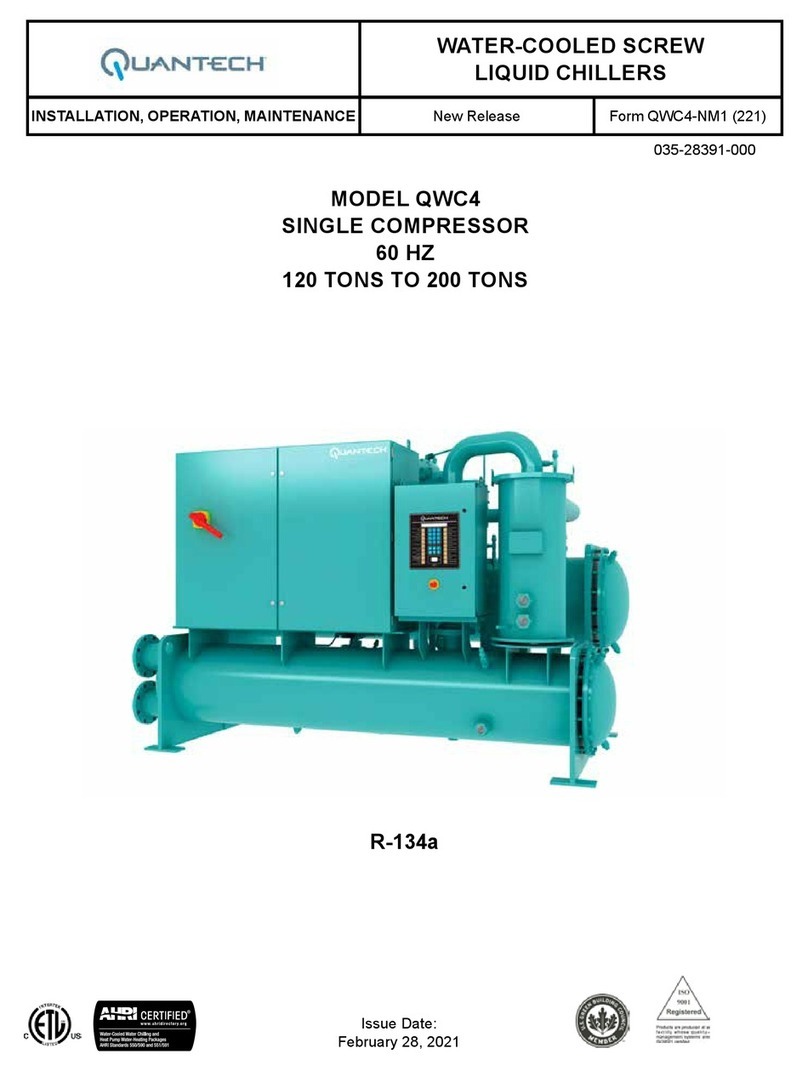
Quantech
Quantech QWC4 Installation operation & maintenance
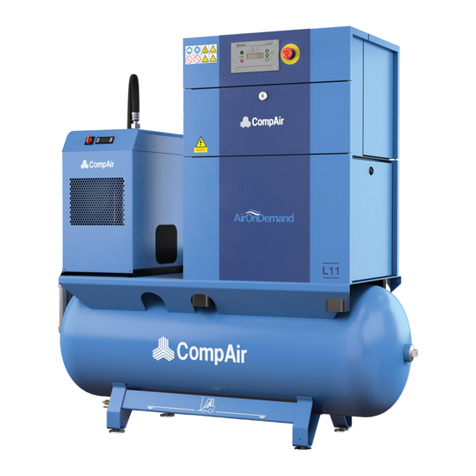
CompAir
CompAir L07RS Operating and service manual
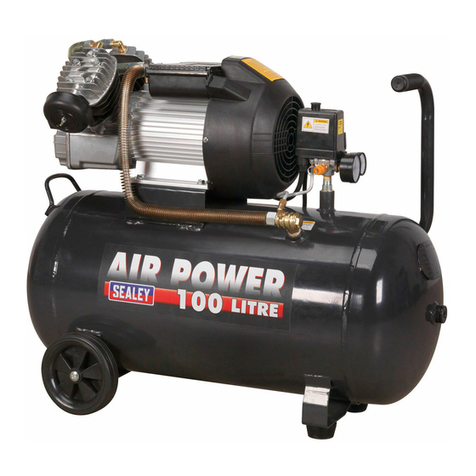
Sealey
Sealey SAC10030VE instructions
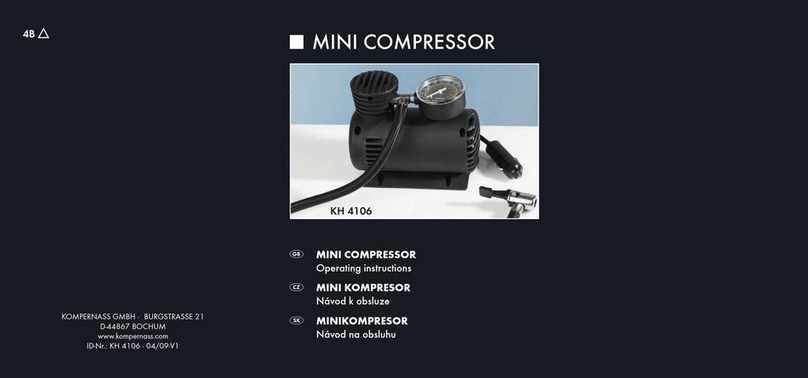
Kompernass
Kompernass MINI COMPRESSOR operating instructions
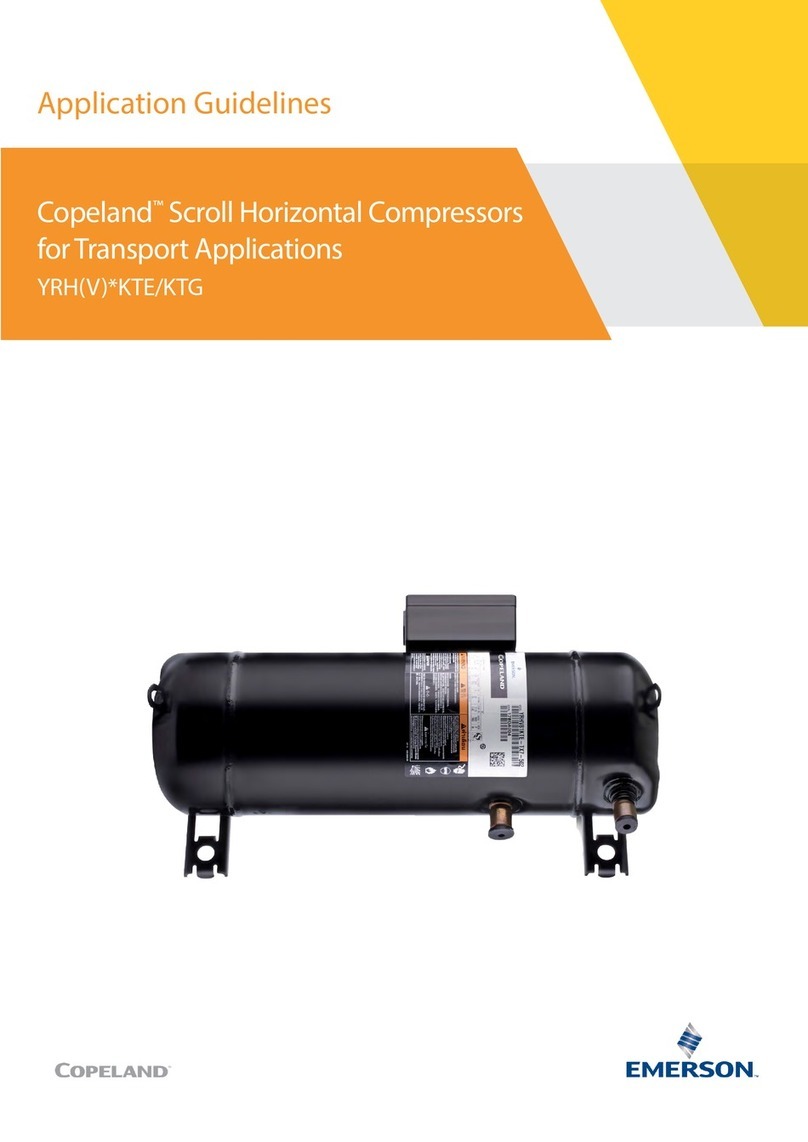
Emerson
Emerson Copeland YRH KTE Series Application guidelines

NATI
NATI Speedway 52619 operating instructions
